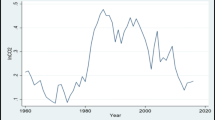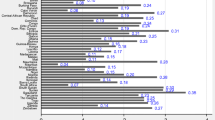Abstract
We examine the impact of trade and political institutions on environmental quality in Africa and explore whether political institutions matter to the trade–environment relationship. We use data from a large group of African countries, covering the period 1990–2008 and two indicators of environmental quality: net forest depletion and CO2 emissions. Results from GMM-SYS estimates suggest that political institutions influence the relationship between trade and environmental quality only in the case of CO2 emissions. Interestingly, we find that polity has a U relationship with net forest depletion. In addition, the results are in favor of an environmental Kuznets curve in the case of pollution but not in the case of net forest depletion. Finally, the results suggest that urbanization has a positive and linear impact on CO2 emissions, while it has a U-shaped relationship with deforestation. We discuss the policy implications of these findings.

Source of data: World development indicators online database (www.worldbank.org)

Source of data: World development indicators online database (www.worldbank.org)

Source of data: World development indicators online database (www.worldbank.org)

Source of data: World development indicators online database (www.worldbank.org)

Source of data: World development indicators online database (www.worldbank.org)
Similar content being viewed by others
References
Adams, M., G. Osho, and Q. Coleman. 2008. The Politics and Political Implications of Oil and Gas Exploration in Africa: An Analysis of American Oil Corporations in Nigeria. International Business & Economics Research Journal, 7(12): 107–116.
Araujo, C., C.A. Bonjean, J.-L. Combes, and P.C. Motel. 2009. Property Rights and Deforestation in the Brazilian Amazon. Ecological Economics, 68: 2461–2468.
Arellano, M., and O. Bover. 1995. Another Look at the Instrumental Variable Estimation of Error-Components Models. Journal of Econometrics, 68: 29–52.
Arnold, J.M., G. Kohlin, and R. Persson. 2006. Woodfuels, Livelihoods, and Policy Interventions: Changing Perspectives. World Development, 34(3): 596–611.
Azomahou, T, F. Laisney, and P. Nguyen Van. 2006. Economic Development and CO2 Emissions: A Nonparametric Panel Approach. Journal of Public Economics, 90: 1347–1363.
Baliamoune-Lutz, M. 2011. Growth by Destination (Where You Export Matters): Trade with China and Growth in African Countries. African Development Review, 23(2): 202–218.
Baltagi, B.H., J. Hidalgo, and Q. Li. 1996. A Nonparametric Test for Poolability Using Panel Data. Journal of Econometrics, 75: 345–367.
Bernauer, T., and V. Koubi. 2009. Effects of Political Institutions on Air Quality. Ecological Economics, 68: 1355–1365.
Bhattarai, M., and M. Hammig. 2001. Institutions and the Environmental Kuznets Curve for Deforestation: A Cross-Country Analysis for Latin America, Africa, and Asia. World Development, 29(6): 995–1010.
Blundell, R., and S. Bond. 1998. Initial Conditions and Moment Restrictions in Dynamic Panel Data Models. Journal of Econometrics, 87(1): 115–143.
Blundell, R., and S. Bond. 2000. GMM Estimation with Persistent Panel Data: An Application to Production Functions. Econometric Reviews, 19: 321–340.
Bond, S., A. Hoeffler, and J. Temple. 2001. GMM Estimation of Empirical Growth Models. Oxford: Oxford University.
Bulte, E.H., and D.P. van Soest. 2001. Environmental Degradation in Developing Countries: Households and the (Reverse) Environmental Kuznets Curve. Journal of Development Economics, 65: 225–235.
Clark, J. 2004. Forest Policy for Sustainable Commodity Wood Production: An Examination Drawing on the Australian Experience. Ecological Economics, 50: 219–232.
Cole, M.A. 2000. Air Pollution and ‘Dirty’ Industries: How and Why Does the Composition of Manufacturing Output Change with Economic Development? Environmental and Resource Economics, 17(1):109–123.
Cole, M.A. 2004. Trade, the Pollution Haven Hypothesis and the Environmental Kuznets Curve: Examining the Linkages. Ecological Economics, 48: 71–81.
Cole, M.A., R.J.R. Elliott, and P.G. Fredriksson. 2006. Endogenous Pollution Havens: Does FDI Influence Environmental Regulations? Scandinavian Journal of Economics, 108: 157–178.
Cole, M.A., and E. Neumayer. 2004. Examining the Impact of Demographic Factors on Air Pollution. Population and Development Review, 2(1):5–21.
Congleton, R.D. 1992. Political Institutions and Pollution Control. The Review of Economics and Statistics, 74(3): 412–421.
Copeland, B.R., and M.S. Taylor. 2004. Trade, Growth, and the Environment. Journal of Economic Literature, 42: 7–71.
Cropper, M., and C. Griffiths. 1994. The Interaction of Populations, Growth and Environmental Quality. American Economic Review, 84(2): 250–254.
Culas, R.J. 2007. Deforestation and the Environmental Kuznets Curve: An Institutional Perspective. Ecological Economics, 61: 429–437.
Damette, O., and P. Delacote. 2011. Unsustainable Timber Harvesting, Deforestation and the Role of Certification. Ecological Economics, 70: 1211–1219.
Dasgupta, S., B. Laplante, H. Wang, and D. Wheeler. 2002. Confronting the Environmental Kuznets Curve. Journal of Economic Perspectives, 16(1): 147–168.
de Bruyn S.M., J.C.J.M. van den Bergh, and J.B. Opschoor. 1998. Economic Growth and Emissions: Reconsidering the Empirical Basis of Environmental Kuznets Curves. Ecological Economics, 25: 161–175.
DeFries, R.S., T. Rudel, M. Uriarte, and M. Hansen. 2010. Deforestation Driven by Urban Population Growth and Agricultural Trade in the Twenty-First Century. Nature Geoscience, 3: 178–181.
Dinda, S. 2004. Environmental Kuznets Curve Hypothesis: A Survey. Ecological Economics, 49: 431–55.
Dodman, D. 2009. Blaming Cities for Climate Change? An Analysis of Urban Greenhouse Gas Emissions Inventories. Environment and Urbanization, 21(1): 185–202.
Ekins, P. 1997. The Kuznets Curve for the Environment and Economic Growth: Examining the Evidence. Environment and Planning, 29: 805–830.
Eskeland, G.S., and A.E. Harrison. 2003. Moving to Greener Pastures? Multinationals and the Pollution Haven Hypothesis. Journal of Development Economics, 70(1): 1–23.
Fisher, M., and G. Shively. 2005. Can Income Programs Reduce Tropical Forest Pressure? Income Shocks and Forest Use in Malawi. World Development, 33(7): 1115–1128.
Fredriksson, P.G., and J.R. Wollscheid. 2007. Democratic Institutions versus Autocratic Regimes: The Case of Environmental Policy. Public Choice, 130(3): 381–393.
Friedl, B., and M. Getzner. 2003. Determinants of CO2 Emissions in a Small Open Economy. Ecological Economics, 45(1): 133–148.
Galeotti, M., and A. Lanza. 1999. Desperately Seeking (Environmental) Kuznets. Fondazione Eni Enrico Mattei Note di Lavoro: 02/99.
Gassebner, M., M.J. Lamla, and J.-E. Sturm. 2011. Determinants of Pollution: What Do We Really Know? Oxford Economic Papers, 63(3): 568–595.
Gbadebo, A.M., A.M. Taiwo, and U. Eghele. 2010. Environmental Impacts of Drilling Mud and Cutting Wastes from the Igbokoda Onshore Oil Wells, Southwestern Nigeria. Indian Journal of Science and Technology, 3(5): 504–510.
Grossman G.M., and A.B. Krueger. 1995. Economic Growth and the Environment. Quarterly Journal of Economics, 110: 353–377.
Hamilton, C., and H. Turton. 2002. Determinants of Emissions Growth in OECD Countries. Energy Policy, 30: 63–71.
Imoobe, T. and T. Iroro. 2009. Ecological Restoration of Oil Spill Sites in the Niger Delta, Nigeria. Journal of Sustainable Development in Africa, 11(2): 45–65.
Jagger, P., J. Pender, and B. Gebremedhin. 2005. Trading Off Environmental Sustainability for Empowerment and Income: Woodlot Devolution in Northern Ethiopia. World Development, 33(9): 1491–1510.
Koop, G., and L. Tole. 1999. Is There an Environmental Kuznets Curve for Deforestation? Journal of Development Economics, 58(1): 231–244.
Kuznets, S. 1955. Economic Growth and Income Inequality. American Economic Review, 45: 1–28.
Lamla, M.J. 2009. Long-Run Determinants of Pollution: A Robustness Analysis. Ecological Economics, 69: 135–144.
Leitão, N.C., and M. Shahbaz. 2013. Carbon Dioxide Emissions, Urbanization and Globalization: A Dynamic Panel Data. Economic Research Guardian, 3(1): 22–32.
Li, Q., and R. Reuveny. 2006. Democracy and Environmental Degradation. International Studies Quarterly, 50(4): 935–956.
Lopez, R., and S. Mitra. 2000. Corruption, Pollution, and the Kuznets Environment Curve. Journal of Environmental Economics and Management, 40(2):137–150.
Motel, P.C., R. Pirard, and J.-L. Combes. 2009. A Methodology to Estimate Impacts of Domestic Policies on Deforestation: Compensated Successful Efforts for “Avoided Deforestation” (REDD). Ecological Economics, 68(3): 680–691.
Myers, N. 1994. Tropical Deforestation: Rates and Patterns, in The Causes of Tropical of Tropical Deforestation. The Economic and Statistical Analysis of Factors Giving Rise to the Loss of the Tropical Forest, edited by Katrina Brown and David William Pearce. London: UCL Press, 27–40.
Opukri, C.O., and I.S. Ibaba. 2008. Oil Induced Environmental Degradation and Internal Population Displacement in the Nigeria’s Niger Delta. Journal of Sustainable Development in Africa, 10(1): 173–193.
Owolabi, O., and I. Okwechime. 2007. Oil and Security in Nigeria: The Niger Delta Crisis. Africa Development, 32(1): 1–40.
Palmer, C. 2011. Property Rights and Liability for Deforestation under REDD+: Implications for ‘Permanence’ in Policy Design. Ecological Economics, 70: 571–576.
Panayotou, T. 1993. Empirical Tests and Policy Analysis of Environmental Degradation at Different Stages of Economic Development, ILO, Technology and Employment Programme, Geneva.
Patel, S.H., T.C. Pinckney, and K. Jaeger. 1995. Smallholder Wood Production and Population Pressure in East Africa: Evidence of an Environmental Kuznets Curve? Land Economics, 71(4): 516–530.
Poumanyvong, P., and S. Kaneko. 2010. Does Urbanization Lead to Less Energy Use and Lower CO2 Emissions? A Cross-Country Analysis. Ecological Economics, 70(2): 434–444.
Satterthwaite, D. 2009. The Implications of Population Growth and Urbanization for Climate Change. Environment & Urbanization, 21(2): 545–567.
Selden, T.M., and D. Song. 1994. Environmental Quality and Development: Is There a Kuznets Curve for Air Pollution Emissions? Journal of Environmental Economics and Management, 27: 147–162.
Stern, D.I. 1998. Progress on the Environmental Kuznets Curve? Environment and Development Economics, 3: 175–198.
Southgate, D., J. Sanders, and S. Ehui. 1990. Resource Degradation in Africa and Latin America: Population Pressure, Policies and Property Arrangements. American Journal of Agricultural Economics, 72(5): 1259–1263.
Sunderlin, W.D., A. Angelsin, B. Belcher, P. Burgers, R. Nasi, L. Santoso, and S. Wunder. 2005. Livelihoods, Forests, and Conservation in Developing Countries: An Overview. World Development, 33(9): 1383–1402.
Tacconi, L. 2009. Compensated Successful Efforts for Avoided Deforestation Versus Compensated Reductions (Commentary). Ecological Economics, 68: 2469–2472.
World Bank. 2008. Environmental Sustainability: An Evaluation of World Bank Group Support. Washington, DC: The World Bank.
Wunder, S. 2003. Oil Wealth and the Fate of the Forest: A Comparative Study of Eight Tropical Countries. London: Routledge.
York, R., E.A. Rosa, and T. Dietz. 2003. STIRPAT, IPAT and ImPACT: Analytic Tools for Unpacking the Driving Forces of Environmental Impacts. Ecological Economics, 46(3): 351–365.
Author information
Authors and Affiliations
Corresponding author
Rights and permissions
About this article
Cite this article
Baliamoune-Lutz, M. Trade and Environmental Quality in African Countries: Do Institutions Matter?. Eastern Econ J 43, 155–172 (2017). https://doi.org/10.1057/s41302-016-0076-8
Published:
Issue Date:
DOI: https://doi.org/10.1057/s41302-016-0076-8




